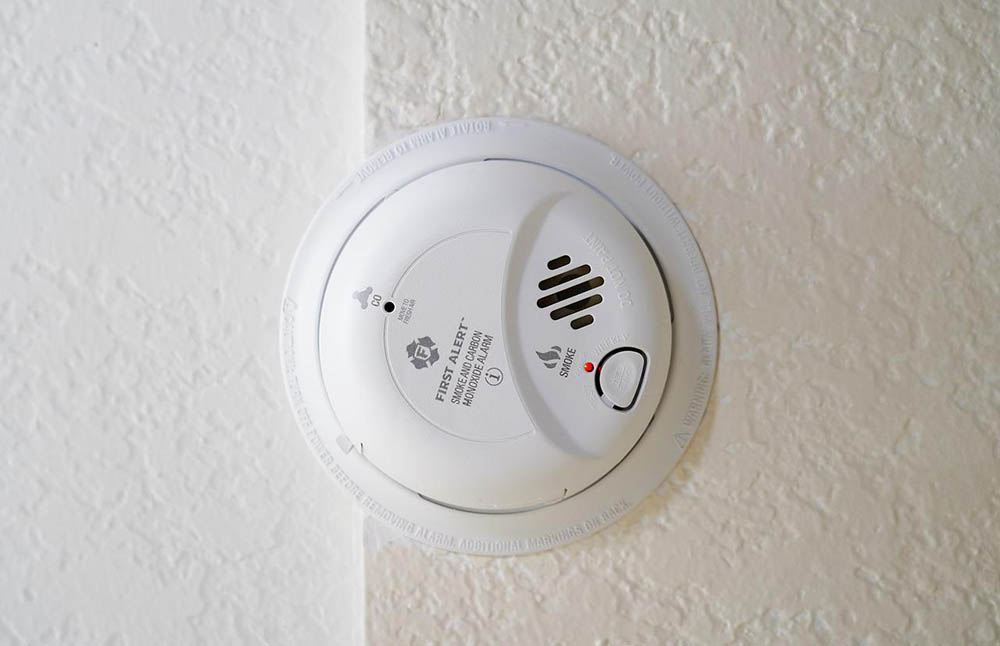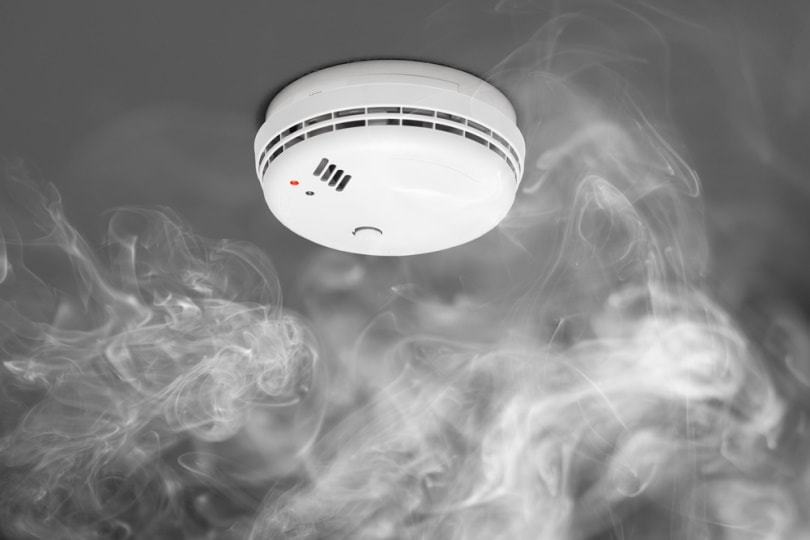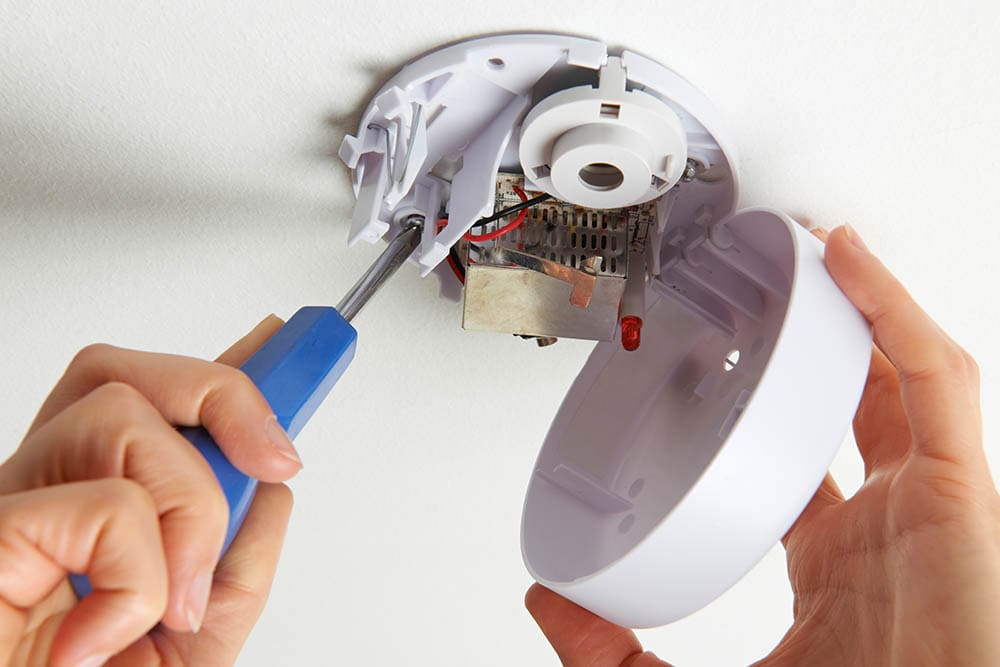Why Is My Smoke Detector Beeping: 7 Possible Reasons
-
Brooke Bundy
- Last updated:

Smoke detectors prevent deaths from home fires by alerting us when there’s smoke or harsh temperature changes. If your house has ever caught on fire, you’re probably grateful for the early warning that allowed you to flee to safety. However, everyone knows that a chirping smoke detector can become a nuisance if it chronically gives you a false alarm. Here’s how to figure out why your smoke detector is acting up, as well as what to do to fix the problem and restore peace to your home.
IMPORTANT: Find out whether your smoke detector is hardwired, or battery operated before you attempt to disconnect. If it’s hardwired, you’ll need to turn off your main electrical breaker first to prevent electric shock.
The 7 Possible Reasons Why Your Smoke Detector Is Beeping
1. There’s Actually a Fire
It probably goes without saying that the first thing you should do when the smoke detector goes off is to take a quick survey of your home to make sure there isn’t a fire. Even if you don’t see flames, take note if any walls or floors feel warmer than usual. Fires may start inside the walls. Also, take note of all your appliances and lamps to see if one might have overheated. If all appears well, you can press the “Test/Silence” button on your smoke detector to silence the beeping or disconnect it from the wall.

2. Low Battery
The most common cause of a beeping smoke detector is a low battery. While your detector will continue to protect your home for quite a few days before it completely dies, you should replace the batteries as soon as possible to keep your home safe (and to guard your ears against the incessant beeping).
3. It’s the Carbon Monoxide Detector
It might not be your smoke detector after all. Your carbon monoxide detector could be picking up excessive amounts of carbon monoxide, or it could need its batteries changed. If it’s only beeping, you might try to change the batteries, but if the alarm sounds you should take all precautions and evacuate immediately—even at the risk of it being only a false alarm.
Unlike a house fire, carbon monoxide is an invisible threat that can poison humans and pets by inhibiting cells from receiving oxygen. You shouldn’t remain in a home where the carbon monoxide detector alarm goes off because the results can be fatal. Evacuate all humans and animals, and immediately call 911. Don’t attempt to return indoors until the issue has been professionally evaluated.

4. The Smoke Detector Itself Needs to be Replaced
You should replace your smoke detectors every 10 years. Check the manufacturing date on the smoke detector to tell if you can’t remember when you installed it.
5. Improper Battery Installation
You might try disassembling the detector and re-installing the batteries to see if it was done incorrectly.
- Turn off the breaker. If your smoke detector is hardwired, the very first step is to turn off your main electrical breaker. You can get shocked if you don’t!
- Remove the cover. Either twist or screw off the cover, depending on the model.
- Replace the batteries. Take out the old batteries and put the new ones in, making sure you align them correctly, pull the tab, and close the cover once you’re finished.
- Test before reinstalling. Press the “test” button before reinstalling the smoke detector. If it chirps once, it’s working fine. You can put it back on its mounting bracket and call it a day. If it doesn’t chirp, check to make sure you installed the batteries correctly. You may need to replace your smoke detector if it still doesn’t work after replacing the batteries.

6. Dinner Is Cooking, or Someone Is Taking a Hot Shower
Dramatic changes in temperature and humidity can set off your alarm. A sizzling fajita on your frying pan may send your detector into a frenzy. Turning on the exhaust vent hood before you start preparing dinner should help prevent the problem. To fix the problem, you should turn on the exhaust vent and fan the steam/smoke out of an open door. You can also open the windows to help clear the smoke faster.
7. Power Surge
If you recently experienced a power outage or lightning strike, your detector might need to be reset. To do this, you’re going to need to turn off the main breaker in your home and take the detector off its mounting bracket. Disconnect the wire plugged into the smoke detector (if it’s hardwired) and take out the battery. Hold down the “Test/silence” button for 15 seconds.
Once the detector quiets down, replace the batteries into the unit and reconnect the wire. After you’ve placed the unit back into the mounting bracket, turn your breaker back on. The detector should make a single beep to indicate it’s working, and then be silent.
How to Choose the Smoke Detector That’s Right for Your Home
You can buy a hardwired smoke detector that’s equipped with a battery backup in the event of power failure, or a battery-operated detector that solely relies on batteries. You’ll need to replace batteries on a hardwired detector when it chirps. Some models need their backup supply changed every six months, but others can last for years. Similarly, the battery powered detectors also differ from each other depending on whether they use lithium powered batteries—which are built to last the entire ten years of your smoke detector’s life—or AA or AAA batteries which should be replaced at least once a year.

- Uninstall the previous smoke detector. Disconnect the previous smoke detector, or plan where to place your smoke detectors if you’re in a new home or changing from battery-operated to hardwired. You should check your local area’s codes to see where they’re required. At the very least, place smoke detectors in every bedroom and preferably outside the sleeping area as well. Don’t install them over stoves, laundry rooms, showers, or places that receive sudden, excessive heat or changes in temperatures.
- Install the new device. Mark where you want the new battery smoke detector to go with a pencil. Drill a small hole through the pencil marks to make holes where the screws will fit into, and then gently hammer plastic screw anchors into the holes you just made. Tighten the screws halfway. Attach the mounting bracket to the screws and rotate the device until it connects. Tighten the screws. Remove the battery pull tab and turn the smoke alarm counterclockwise to secure it. Test the device to make sure it’s been installed correctly. It should beep once, and then you’re all set.
How To Install a New Hardwired Smoke Detector

1. Replace the old detector or scout out a new spot.
Replace the old, hardwired device the same way you would replace the batteries if you’re keeping the same location. If you’re choosing another location for your new detector, the process becomes a little trickier. You’ll need to turn off the main breaker, and then use a stud finder to identify a good spot to place your device.
Mark the center with a pencil and drill a hole, and then using that hole as the center, draw a circle on your ceiling that’s the circumference of your device. Using a drywall saw, cut around the circle and then test to see if your device will fit in the hole, you just made, but don’t leave it there just yet.
2. Attach the 14-2 NM cable.
Run a 14-2 NM cable from the house breaker panel through the hole in the center. Pull about 10 inches of the cable through the ceiling. Strip the sheathing off the cable to reveal the inner wires and insert the wires through the back of the remodeling box. Screw down the clamping tabs carefully until the box is tight against the wall and attach the copper wires (ground wires) to the box.

3. Attach the wiring harness.
You’ll need to expose 3/4” of the wire with wire strippers and then connect the wires to a 120-volt wiring harness, which typically comes with the device. You might want to refer to your device manual for installation steps at this point or call an electrician. If you decide to proceed, connect like colors together with wire nuts (red to red, and white to white).
You’ll also need to ensure your new device connects with the other detectors in your house through the wire harness and the wires that run from the breaker panel to the other devices. There should be wires running between the alarms. Wrap the wire connectors with electrical tape for extra protection. Tuck the extra wire length and wire connectors into the remodeling box, and the plug-end of the wire harness on the outside.
- Connect the smoke detector. Fish the wiring harness through the mounting plate of the smoke detector. Align the screw holes of the wiring box with the mounting plate and use screws to connect the plate to the box. Plug the wire harness into the back of the smoke detector.
- Install the back-up batteries. If you haven’t already done so, insert the new backup batteries into the battery box on the device.
- Twist the smoke detector into place and test it out. Make sure the smoke detector is smoothly connected to the mounting plate. If all looks well, turn on the main breaker and test it out.
Additional Troubleshooting
If you’ve replaced the batteries correctly and/or replaced your smoke detector, you might have to call an electrician to see about the problem. There could be an electrical issue in your house, especially if it was recently hit by lightning.
Conclusion
After ensuring there isn’t a fire, the next step on your troubleshooting journey should be to replace the batteries in your beeping smoke detector. If this fails to remedy the problem, you might have to replace your device. You should always replace your device every 8-10 years to keep your home safe, or as needed.
- https://www.bobvila.com/articles/smoke-detector-beeping/
- https://www.homedepot.com/c/ah/how-to-install-a-smoke-detector/9ba683603be9fa5395fab900b634d44
- https://www.vectorsecurity.com/blog/how-to-change-the-battery-in-your-smoke-detector
- https://www.wirechiefelectric.com/blog/resources/what-to-do-when-smoke-alarm-keeps-beeping
- https://www.carrier.com/residential/en/us/products/indoor-air-quality/co-alarm/carbon-monoxide-detector-goes-off/
- https://www.firstalert.com/time-to-change-smoke-alarm-batteries.html
- https://www.tdi.texas.gov/tips/smoke-alarms-where-to-put-them-how-often-to-replace-batteries.html
- https://support.firstalert.com/s/article/install-battery-alarm
Featured Image Credit: Rigby40, Pixabay
Contents
